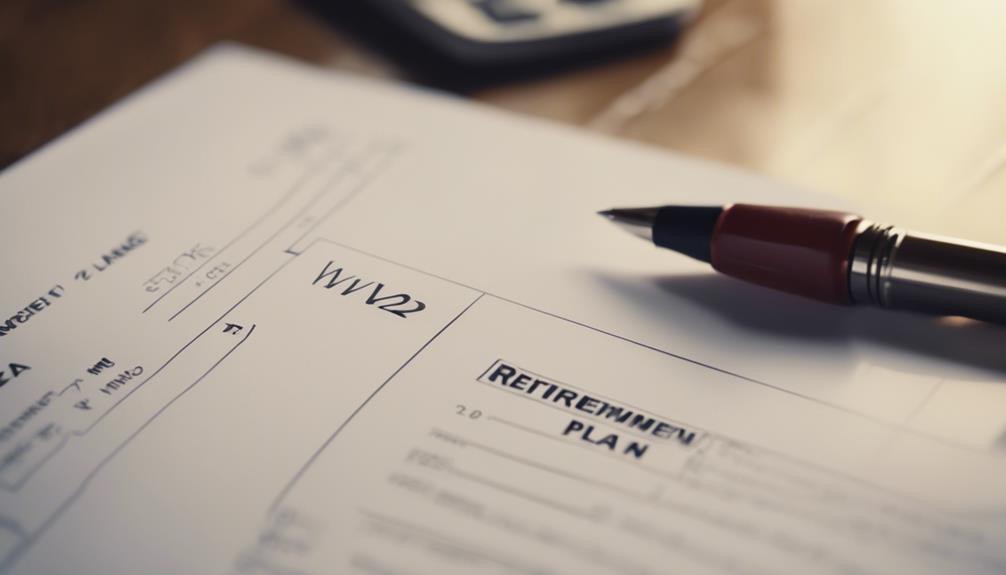Checking off the “Retirement Plan” box on your W-2 form signifies that your employer provides a retirement plan, which can have an impact on tax deductions and financial planning. This action does not automatically enroll you in the plan, but simply confirms its availability. It is crucial for IRS compliance and accurate reporting, which can help optimize your taxes. Understanding Box 13 indicates active participation in qualified plans and tax-deferred savings. It is recommended to seek advice from a tax professional regarding deductions and retirement planning strategies. Employer matching contributions can potentially double your savings, ensuring a secure financial future. Knowing the difference between Roth and Traditional accounts can help tailor your retirement strategy effectively. Maximize your retirement benefits by taking full advantage of the options available on your W-2.
Key Takeaways
- The box indicates plan availability, not enrollment status.
- Employers must check the box if they offer a retirement plan.
- Checking the box impacts tax deductions and financial planning.
- Consult a tax professional for insights on implications.
- Understanding the box helps track progress towards financial security.
Purpose of Retirement Plan Box on W-2
The purpose of the Retirement Plan box on the W-2 form is to indicate whether an employer offers a retirement plan. By checking this box, employers signal to the IRS and employees that a retirement plan is available. It doesn't automatically enroll the employee in the plan, but it highlights the option for retirement benefits.
This distinction is important for tax purposes and can impact the deductions individuals are eligible for. Employers are obligated to mark this box if they provide a retirement plan, regardless of how many employees participate in it.
For employees, seeing this box checked serves as a reminder of the retirement benefits they could potentially access. Understanding the significance of this box empowers employees to make informed decisions about their financial future and encourages them to explore taking advantage of the retirement plan offered by their employer.
Employer's Obligation Vs. Employee's Enrollment

Understanding the distinction between employer obligation and employee enrollment regarding retirement plans is essential for comprehending tax implications and making sound financial decisions. Employers play a vital role in marking the Retirement Plan box on the W-2 form to signify plan availability, irrespective of employee participation. This differentiation holds importance in the domain of tax deductions and financial planning.
Here are some key points to keep in mind:
- Employers are required to check the Retirement Plan box on the W-2 form if they provide a retirement plan.
- The checked box indicates plan availability through the employer, not necessarily employee enrollment.
- Failure to accurately mark the box when offering a plan can lead to penalties for employers.
- Understanding the significance of the checked box helps employees differentiate between plan availability and actual enrollment.
- Employees should be familiar with the Retirement Plan box to grasp its implications for tax deductions and overall financial planning.
IRS Compliance and Reporting Accuracy

How can employers guarantee accurate reporting and IRS compliance when it comes to checking the Retirement Plan box on employees' W-2 forms? Ensuring proper handling of the Retirement Plan indicator is essential for maintaining IRS compliance and avoiding penalties.
By accurately marking this box for all eligible employees, employers demonstrate the availability of a pension plan without implying employee enrollment. This step is critical in fulfilling reporting requirements and meeting IRS guidelines.
The Retirement Plan indicator serves as a key element in tax planning and financial decision-making for both employers and employees. Understanding its significance can help in maneuvering the complexities of retirement investment strategies. It provides a framework for setting long-term financial goals and ensures a more secure future by optimizing contributions and benefits. For those new to the process, exploring retirement planning tips for beginners can be a valuable starting point to build a strong foundation. By leveraging the right strategies and staying informed about available options, individuals can make more confident and informed choices about their retirement journey.
As such, it's imperative for employers to pay close attention to this detail, as it not only impacts compliance but also plays an important role in employees' financial futures. By correctly indicating the availability of a retirement plan, employers contribute to a transparent and compliant reporting process that aligns with IRS regulations.
Tax Implications and Financial Planning

Exploring the tax implications and financial planning considerations associated with checking the Retirement Plan box on your W-2 form reveals essential insights for strategic decision-making. When it comes to taxes and financial planning, understanding the significance of this box is vital. Here are some key points to ponder:
- Tax Benefits: Checking the Retirement Plan box may make you eligible for tax deductions, reducing your taxable income and potentially lowering your overall tax burden.
- Retirement Savings: Enrolling in a retirement plan can be a smart financial move, helping you build a nest egg for the future and secure your retirement.
- Long-Term Financial Security: Planning for retirement is essential for ensuring financial stability in your later years and maintaining your desired lifestyle.
- Employer Contributions: Some employers match contributions to retirement plans, effectively doubling your savings and accelerating your path to a comfortable retirement.
- Professional Guidance: Consult with a financial advisor to optimize your retirement planning strategy and make the most of available tax benefits for a secure financial future.
Importance of Understanding Box 13

Moving from the discussion on tax implications and financial planning, we now shift our focus to the significance of Box 13 on the W-2 form and its importance for employees participating in retirement plans.
Box 13 indicates active participation in various qualified retirement plans, such as pension, profit-sharing, annuity plans, SEP, SIMPLE retirement accounts, and government plans. Checking this box is vital for individuals covered by these plans, as it reflects their involvement and contributions in tax-deferred savings. Active participation in these plans signifies that you're credited with contributions or forfeitures in a tax year, which can have significant implications for your tax situation and retirement savings.
It's essential to make sure that only qualified plans are indicated in Box 13, as non-qualified or 457(b) plans shouldn't be included. Understanding and correctly reflecting your active participation in retirement plans through Box 13 can help you track your progress towards financial security in retirement.
Consultation With Tax Professional

When considering the Retirement Plan box on your W-2 form, it's advisable to seek guidance from a tax professional. Consulting with an expert can help clarify any uncertainties about the implications of this box.
Tax professionals offer valuable insights on how checking this box may impact your tax deductions.
Tax Professional Advice
Seeking guidance from a tax professional can provide essential insights into the implications of the Retirement Plan box checked on your W-2 form. Tax professionals play an important role in clarifying how this box may affect your tax deductions, retirement planning strategies, and legal obligations. Here are some key points to keep in mind when seeking advice:
- Tax professionals can explain the impact on tax deductions.
- They help differentiate between coverage and active enrollment.
- Guidance on implications for accurate tax reporting.
- Assistance in understanding legal obligations.
- Clarity on the implications for retirement planning strategies.
Consulting with a tax professional helps in gaining a thorough understanding of the implications and obligations related to the Retirement Plan box on your W-2 form.
Expert Consultation Benefits
To guarantee a thorough understanding of the implications of the Retirement Plan box on your W-2 form, consulting with a tax professional is invaluable for accurate financial planning. Tax experts can provide insights into how the checked box may affect your tax deductions and overall financial strategies.
Expert consultation guarantees a precise grasp of the significance of the Retirement Plan box for tax purposes, helping distinguish between mere coverage by a retirement plan and active participation in it. Seeking professional advice empowers employees to make well-informed decisions regarding their retirement benefits based on the information presented in the W-2 form.
Maximizing Retirement Benefits

When considering retirement benefits, it's crucial to explore the tax advantages associated with retirement accounts, the potential for employer matching contributions, and the differences between Roth and Traditional accounts.
By understanding these key points, individuals can make informed decisions that maximize their retirement savings and overall financial security.
Taking advantage of employer contributions and selecting the right type of retirement account can greatly impact one's long-term financial well-being.
Tax Advantages of Retirement
Maximizing retirement benefits involves strategically leveraging the tax advantages provided by retirement plans to enhance financial security during retirement.
When considering retirement planning, understanding the following key points is crucial:
- Contributions to retirement plans can greatly lower taxable income, reducing current tax liability.
- Employer-sponsored retirement plans often include matching contributions, boosting retirement savings.
- Tax-deferred growth in retirement accounts allows investments to grow faster over time.
- Utilizing retirement plan options can lead to a more secure financial future during retirement.
Employer Matching Contributions
Employer matching contributions in retirement plans provide a valuable benefit to employees by doubling their retirement savings potential. When participating in a pension plan, taking full advantage of employer matching contributions is vital for maximizing retirement benefits.
By contributing an amount that guarantees receiving the full employer match, employees can effectively double their retirement savings. Employers commonly offer matching formulas such as dollar-for-dollar matches or percentage matches, varying in generosity. Understanding the employer's matching contribution policy is essential for optimizing retirement savings and securing a financially stable future.
Roth Vs. Traditional Accounts
We should carefully consider whether to opt for a Roth or traditional retirement account to maximize our benefits. When deciding between the two options, it's crucial to weigh the advantages and drawbacks of each based on our financial goals and tax situation. Here are some key points to keep in mind:
- Roth accounts are funded with after-tax dollars, offering tax-free withdrawals in retirement.
- Traditional accounts are funded with pre-tax dollars, providing tax-deferred growth.
- Roth accounts have income limits for contributions, unlike Traditional accounts.
- Roth accounts are suitable for those expecting a higher tax bracket in retirement.
- Traditional accounts are ideal for individuals in a higher tax bracket presently.
Making the right choice between Roth and traditional IRA contributions can have a significant impact on our retirement savings strategy.
Frequently Asked Questions
Do Retirement Plan Contributions Show up on W-2?
Retirement plan contributions show up on the W-2 form in Box 12 with codes like D, S, or E. Checking the Retirement Plan box in Box 13 indicates active participation. Employers must accurately report this information to the IRS for compliance.
What Does Box 14 of W-2 Say About Retirement?
In Box 14 of the W-2 form, employers can include various details like union dues or state disability insurance. This section offers additional information beyond tax essentials. It's important to review Box 14 for any extra benefits or pertinent data provided by the employer.
Does Box 16 on W-2 Include 401k?
Box 16 on the W-2 form shows employee wages subject to various pre-tax deductions. It includes 401(k) elective deferrals along with other deductions like health insurance premiums. Employers must accurately report these deductions for tax purposes.
What Are Boxes 12a, 12b, and 12C on the W-2 Form?
Boxes 12a, 12b, and 12c on the W-2 form report elective deferrals to 401(k), 403(b), and 457(b) plans, respectively. They help us track contributions accurately. Misreporting can result in tax errors and penalties. Proper use is essential.
Conclusion
To summarize, checking the retirement plan box on your W-2 form is vital for ensuring accurate reporting to the IRS and maximizing your retirement benefits.
Understanding the implications of this box, consulting with a tax professional, and planning for your financial future are all key steps in securing a comfortable retirement.
Take the time to review your W-2 form carefully and make informed decisions to set yourself up for a secure and prosperous retirement.










